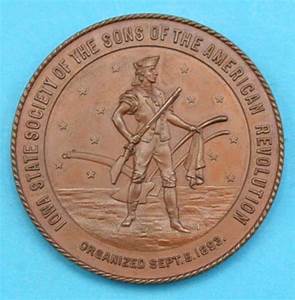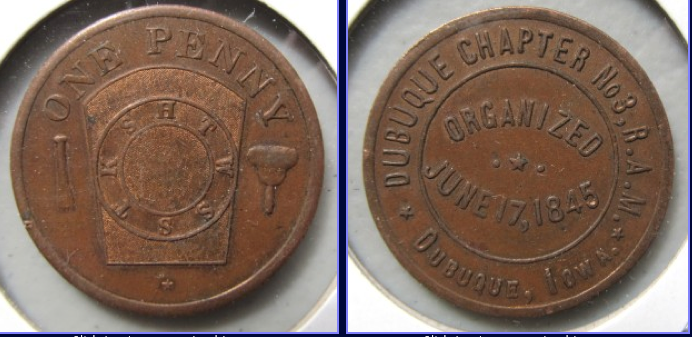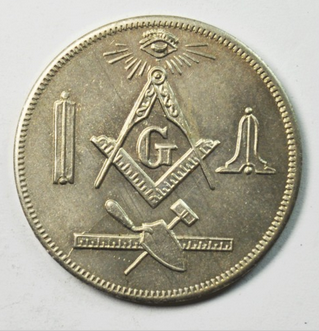Encyclopedia Dubuque
"Encyclopedia Dubuque is the online authority for all things Dubuque, written by the people who know the city best.”
Marshall Cohen—researcher and producer, CNN
Affiliated with the Local History Network of the State Historical Society of Iowa, and the Iowa Museum Association.
CHALLENGE COINS
CHALLENGE COINS. The origin of challenge coins is often influenced by the researcher. A writer for the Department of Defense quoted Air Force Historical Research Agency archivist Barry Spink. He had been told in the 1990s that the tradition started in Vietnam. An Army infantry-run bar tried to keep non-infantrymen away by forcing “outsiders” to buy drinks for the whole bar if they couldn’t prove they had been in combat. The “proof” started with enemy bullets. That got a little out of control with grenades, rockets and unexploded ordnance. A coin-sized item emblazoned with the unit’s insignia became the accepted form of proof.
Spink also directed the writer to a 1994 edition of Soldier Magazine. According to an article a member of the 11th Special Forces Group took old coins, overstamped with a different emblem, then presented them to unit members. This was according to Roxanne Merritt, curator of the John F. Kennedy Special Warfare Museum at Fort Bragg, N.C. A former commander of the 10th SFG became the first to mint a unit coin for the U.S. military unit. The 10th group remained the only Army unit with its own coin until the mid-1980s. (1)
One of most repeated stories associated with the beginning of the coin dates the beginning of its use to WORLD WAR I. An air force squadron lieutenant ordered a solid bronze medallion carrying the squadron emblem for every member. He carried his medallion in a pouch around his neck. According to the story, the lieutenant's aircraft during battle was severely damaged by ground fire. Forced to land behind enemy lines, he was immediately captured by a German patrol. To discourage his escape, the Germans took his uniform and all personal identification but ignored the small leather pouch around his neck.
Taking advantage of a bombardment that night, he escaped. He succeeded in avoiding German patrols and reached the front lines were he stumbled into a French outpost. Saboteurs masquerading as civilians were a constant threat and no recognizing the young pilot’s American accent the French thought the worse set to execute him. Remembering the coin in the leather pouch, he showed the coin to his would be executioners. His French captors recognized the squadron symbol on the coin and delayed long enough to confirm his identity. Back at his squadron, and after hearing his story, it became a tradition to ensure that all members carried their coin at all times. (2)
Providing identification takes the challenge coin's history further back to the Renaissance in France and the French Protestants called the Huguenots. France in the late 1600s was a Catholic nation and Protestantism was considered a heresy. Those who pursued were likely to be persecuted by King Charles XIV. Many fled the country, but those who remained continued to conduct religious services in secret. To avoid spies, the Huguenots used their circular communion token, called a méreau, to prove their allegiance and gain admission to church services if challenged. (3)
The use of challenge coins has exploded since the late twentieth century. Challenge coins became popular in fraternal organizations; public service organizations including police and fire departments; and politics. For the latter group, Congress has produced them for politicians to give to constituents. United States presidents have given them out since the 1990s. Eagle Scouts have a challenge coin as does the World Series of Poker. (4)
An individual carrying an organization's challenge coin was under a pledge to carry out the ideals of the organizations and all the rules the challenge coin carried. An example follows:
Challenge Coin Rules
●The challenge is initiated by drawing your coin, holding it in the air by whatever means possible and state,
shout or otherwise verbally acknowledge that you are initiating a coin check. You may also place it or strike
it on a hard surface such as a table. If you accidentally drop your coin and it makes an audible sound it is
still considered a challenge.
●The response consists of all those present responding in a like manner within 15 seconds. At the time of the
challenge you are allowed one step and an arm’s reach to locate your coin. All coin holders present will
participate during a challenge. A response can be with any other challenge coin.
●If there is a challenge and a person is unable to respond then the individual(s) without their coin are
required to buy a meal and or beverage of choice for the individual who issued the challenge.
●If everyone being challenged responds with their coin then the person who challenged is required to buy a
meal for all those he/she challenged.
●Failure to buy a meal and or beverage is considered despicable and a failure of unit trust. Some units
require that you return your coin should you do so.
●Coin checks are allowed anytime, anywhere and anyplace. There are no exceptions to the rule.
●An organization or unit coin is a coin. Belt buckles are belt buckles, key chains are key chains. However
a coin placed in some fashion around the neck is considered a coin.
●You are responsible for your coin. If someone else is looking at or accidentally drops your coin on a
hard surface you are responsible for the consequences of the challenge. However, no one can borrow your
coin and force a challenge.
●Once you agree to carry a coin it comes with an obligation of group loyalty and traditions of the coin. Don’t
accept a coin if you do not share the values and beliefs of the group shared with a willingness to respect
the traditions of the challenge coin.
Challenge coins can be ranked. An example of such a ranking follows:
Medal of Honor recipients receive challenge coins and theirs outrank all others.
Officer coins given out by fraternal organizations use the following system:
Incumbent officers outrank past presidents and are senior.
Presidents outrank other officers in descending order to be chosen.
Past officers are ranked in order of senior to newest
Committee coins use the same reasoning as above
Chapter coins are ranked by the earliest chapter date.
Promotional coins are given to commemorate organization events
Self-purchased coins
---
Source:
1. Lange, Katie, "The Challenge Coin Tradition: Do You Know How It Started? U.S. Department of Defense, October 8, 2027, Online: https://www.defense.gov/News/Inside-DOD/Blog/article/2567302/the-challenge-coin-tradition-do-you-know-how-it-started/
2. "History of the Challenge Coin," Syracuse University-Department of Public Safety, Online: https://dps.syr.edu/law-enforcement/history-of-the-challenge-coin/
3. Rhodes, Michael, "The History and Present-Day Use of Challenge Coins," SAR (Sons of the American Revolution) Magazine, Vol. 118, No. 3, p. 20
4. Ibid.






